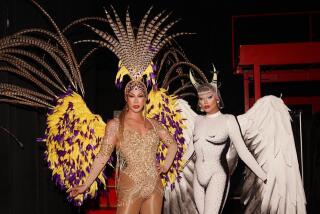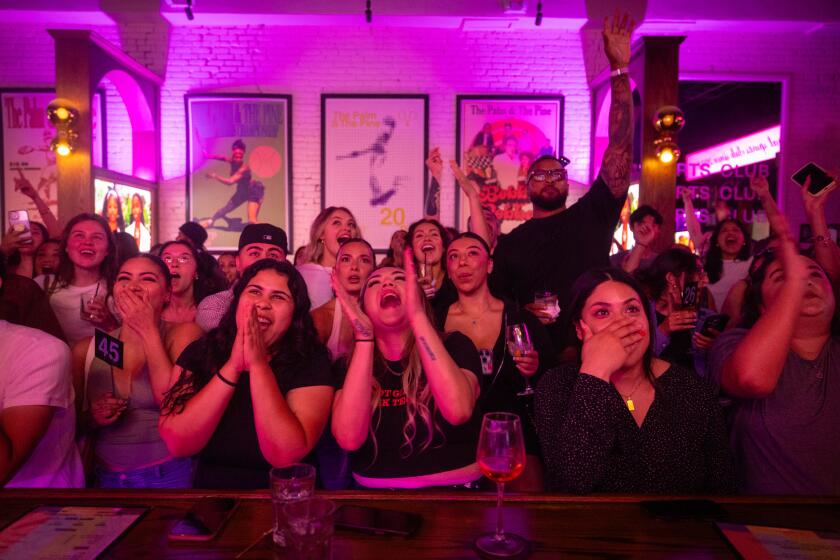SOLO IN POGO : Simi Valley’s Kathy Gray Earns Wings as Only Woman in U. S. to Race Formula One Midgets
- Share via
The scene is inside the cockpit of a midget airplane that’s traveling more than 200 m. p. h. around a three-mile race course: Throttle open, Kathy Gray is redlining the little 100-horsepower engine, banking past a pylon at full bore. Without warning, a jolt on the starboard wing--a blow so sharp that it literally knocks out her contact lenses--sends the plane lurching out of control.
On the ground, her mechanic, George Kirstner, has seen what happened: There was a mid-air collision, another plane clipping her right wing. Now, Kirstner watches Gray’s tiny plane “do wild gyrations and then dive toward the crowd.”
Gray managed to regain control and--after coolly locating her contacts and placing them back in her eyes--she landed the plane. When Kirstner got to her, she dismissed her brush with disaster. So what if she’d been half-blind in a careening aircraft at low altitude?
“It was a pretty hairy situation,” Kirstner says of the incident two years ago in Pueblo, Colo. “But she seemed to think it was nothing. That’s Kathy, though. She never gets shook up.”
Gray, 38, is so cool she even lives on Nonchalant Drive in Simi Valley. And when she flies--besides racing, she ferries planes all over the world for a living--Gray takes a casual, fatalistic approach to danger.
“If you have a structural failure, you have to accept the fact that you probably won’t survive,” she says. “But I’ve come to terms with that. You have to take every precaution, but if it happens, it happens. At least it will be quick.”
Barely 5 foot, Gray doesn’t look like a character from a Hemingway novel, but she has led a globe-trotting life of adventure. A professional flier for 15 years, Gray is one of a handful of women pilots in the profession and is the only woman in the country who races Formula One midgets. She recently finished second in the silver division at the National Air Races in Reno.
“Racing is something I wanted to do since I started flying,” Gray says. “The midgets really appealed to me because they’re the only plane designed to race and nothing else. To me, that’s the ultimate.”
Air races are just like auto races, only higher. They take place around pylons, with as many as eight midgets--each 600 pounds, with 16-foot wingspans--taking part, often flying only 15 feet off the ground during the eight-lap race. Some midgets generate speeds approaching 300 m. p. h. on straightaways, and death is always the co-pilot. At the Reno races, a midget pilot was killed when his plane got caught in a dust devil and crashed.
The sport has not attracted many women. There are believed to have been only three others besides Gray. One was killed and the other two dropped out, Kirstner says. One of them, JoAnn Alfred, retired and sold Gray her plane, named Pogo. Gray bought it in 1987 for $10,000, and “it needed a lot of work,” Gray says. With the help of Kirstner, who works for Marple Aviation at Santa Paula Airport, she rebuilt the engine and replaced the chassis fabric.
“I’d be nowhere without someone to work on the plane,” she says. Kirstner works without pay and travels to air shows with Gray, splitting her winnings. At Reno, she won $2,600, a tidy sum, but air races don’t occur often enough--there won’t be another until next spring--to pay their expenses and overhead. Gray enters only three or four races a year and has earned $5,000-$6,000 each year she has raced, she says.
Gray finds her thrills between races by flying planes--monster-sized Soviet Ilyushins to little Cessnas--across oceans to their new owners. In a good year, she averages two solo trips to Africa every month, each trip taking five or six days, with long hours spent crossing great expanses of ocean. Then, when she lands, she has to deal with Third World red tape, bureaucrats on the take and language barriers. Once, in Nigeria, she was placed under house arrest after making an emergency landing.
“What you don’t do in Africa is pop in unannounced without clearance,” she says. “That was a bit tricky. I had to do a lot of fast talking.”
A few years ago, she was delivering a five-seat Cessna when an electrical fire sizzled in the cockpit during a rainstorm over Mali. It happened on automatic pilot when she was back checking the extra fuel tanks. With the cabin filling with smoke, she groped forward and sat in the pilot’s seat. Bad idea. The shorted wires were under the seat. Her jeans began to smolder. Communication and navigation systems went out, but she flew into Mali by dead reckoning, “fixed the plane, put on a pair of new pants and went on,” she says matter-of-factly.
Gray, who grew up in Vermont, wanted to be a jockey--she once worked as an exercise girl--but discovered flying in the early ‘70s. Her brother went to a local airport to take flying lessons and Gray “trailed along,” she says. The brother never went up; she did. A couple of years later, she moved to Los Angeles and got a job teaching aerobatics at Santa Paula Airport.
“Flying is like horse racing,” she says. “I just liked it. And I fancied I could make a living at it.”
After working as a DC-3 cargo pilot, Gray was employed in 1987 by Southern Cross Aviation, a Camarillo-based worldwide aircraft delivery company. “It’s my favorite job,” she says. “I see a lot of the world, but I’m also on my own. I take off on my own and land on my own. I have to use ingenuity and I never know what I’m going to run into or what problems with clearances I’m going to have.”
And how do people react when the hatch opens on their brand new expensive airplane and a tiny woman steps out to greet them? “I get some raised eyebrows, especially in places like Japan and the Philippines,” she says. “But for the most part, people don’t care who’s flying as long as their plane gets there in one piece.”
The midget racing fraternity also accepts her, she says. “I’m the source of their jokes, but the men have been fabulous. Their love for racing transcends (the sexes). When I first started, there were guys who were skeptical, but they gave me a chance to prove myself. On the whole, they’ve been very helpful and appreciative to have a woman flying. It gives racing another dimension.”
Despite the omnipresent danger, “Once a race starts, I get a wonderful feeling--I love passing people,” Gray says. “The joyful part is when I land and share the experience with the people I’ve raced with.”
Gray and Kirstner are in the process of building a new plane that is expected to reach lap speeds of 280 m. p. h. “We’re convinced it will be an unbeatable plane,” she says. Gray’s diminutive size is an advantage in midget racing. Her new plane will be custom-built for her, meaning that it will have a smaller fuselage and be more aerodynamically efficient than the competition’s craft.
“I can build it around me,” she says. “It will be a teenie-weenie airplane.”
More to Read
Sign up for The Wild
We’ll help you find the best places to hike, bike and run, as well as the perfect silent spots for meditation and yoga.
You may occasionally receive promotional content from the Los Angeles Times.






